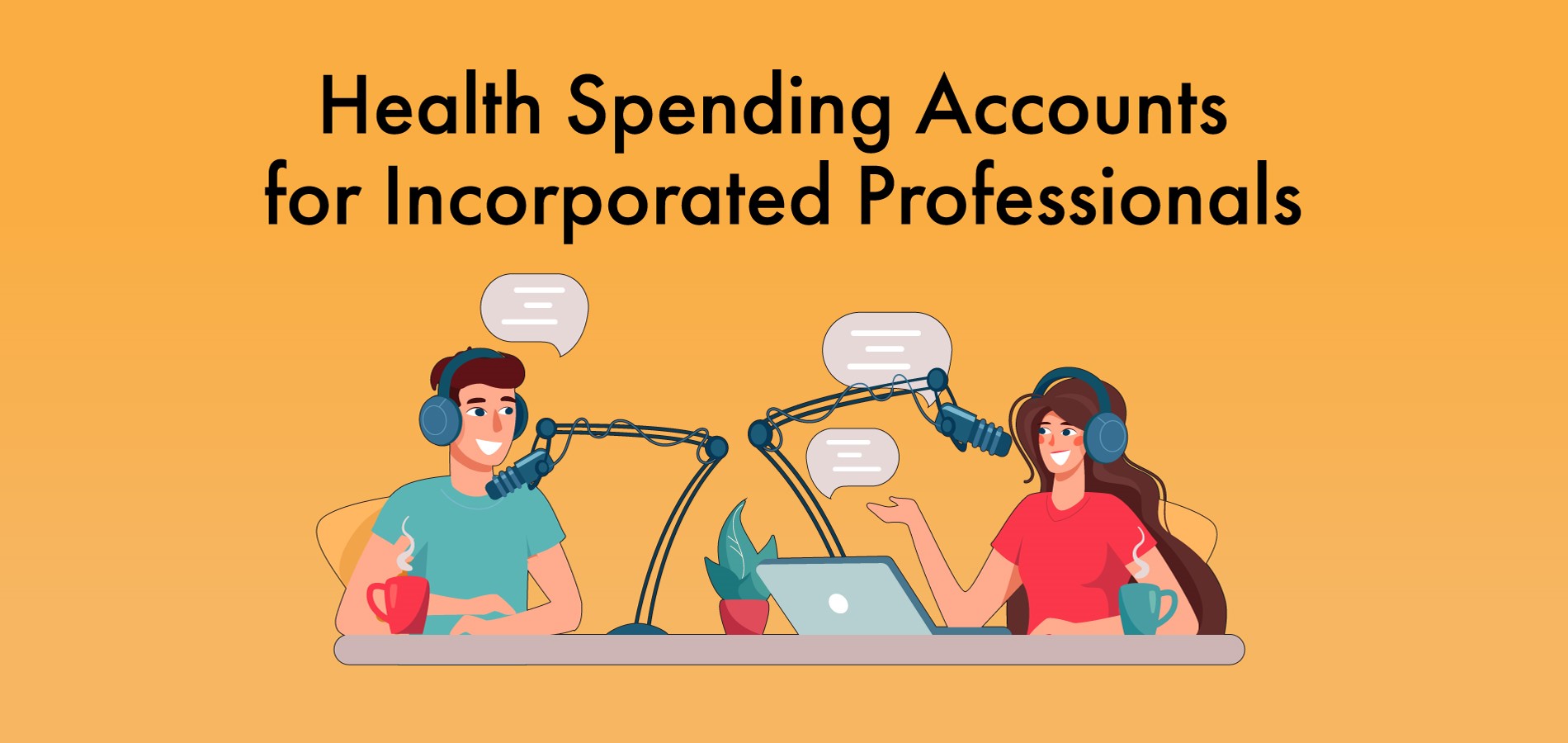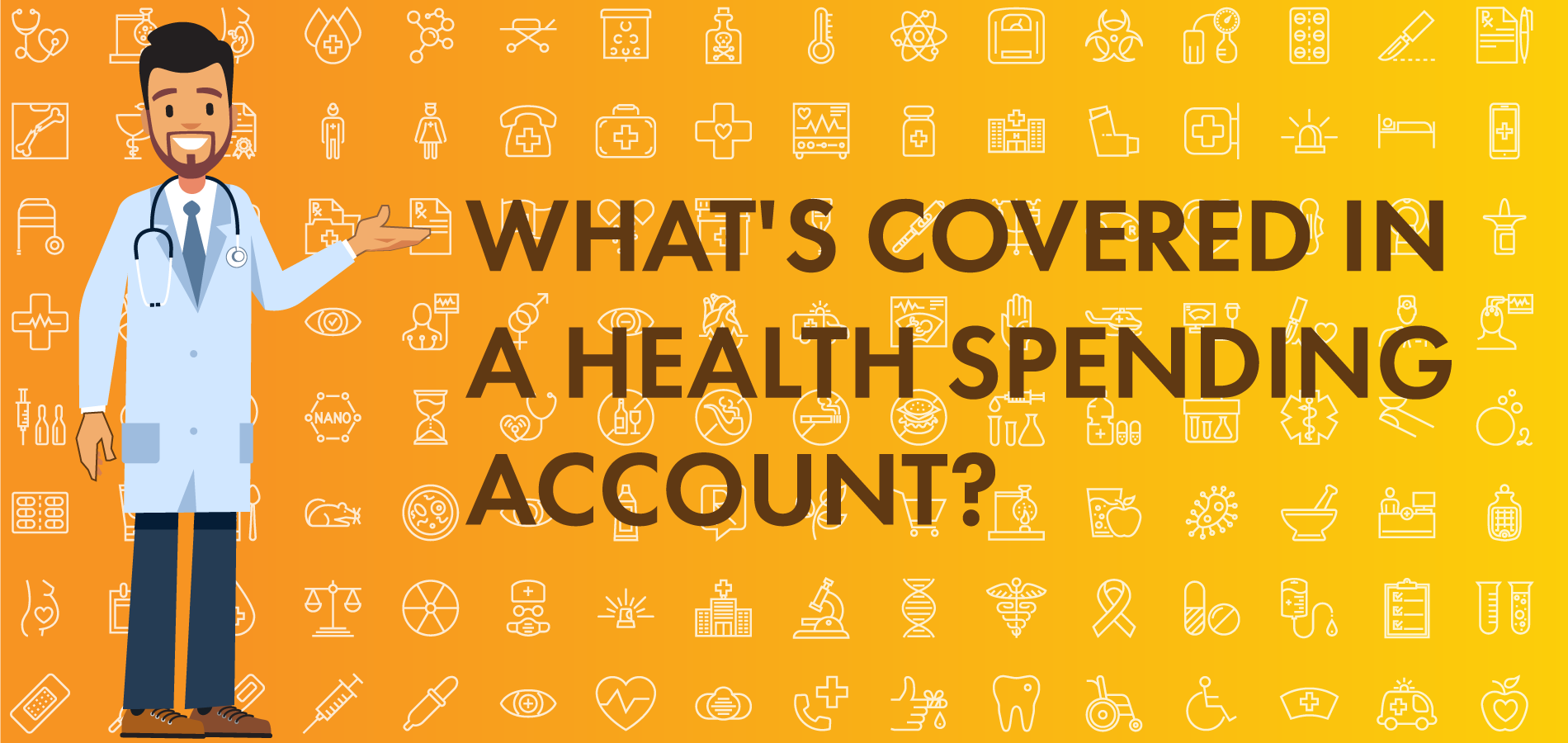Health Spending Accounts for Incorporated Professionals (Interview)
Health Spending Accounts (HSAs) help business owners reduce taxes and healthcare costs. This interview walks incorporated professionals through everything they need to know about HSAs, from what they are, to how they are CRA compliant. To hear the full episode, visit the Podcast.
Table of Contents
Click to be directed to a section:
1. What is a health spending account and what does it cover?
2. With it covering health and dental, how would this compare to a more traditional insurance plan or a traditional health insurance plan?
3. Is this something that can be used in any province?
4. What does a business owner need to qualify for this plan?
5. What happens if you have a pre-existing health condition?
6. Is it just for the business owner or can you also cover your family, your dependents, that sort of thing?
7. Is this legal? Is this a tax loophole?
9. It sounds like the claims process makes you pay twice. Can you clarify?
10. How long does reimbursement take?
12. What about the rumors of CRA shutting down HSAs?
13. Why is Olympia's Health Spending Account a good one?
14. What is the sign up process like?
15. Could you give me a quick overview for HSAs with employees other than the business owner?
1. What is a health spending account and what does it cover?
Dan: Okay, so, a Health Spending Account is a plan or a structure set up by a small business owner that allows their business to expense their health and dental bills. A Health Spending Account is a flexible benefit if you will, that the employer pulls from their corporation and its tax-free in their hands. Obviously, very attractive because there is not too many things that work that way. But in this case, the Health Spending Account covers pretty much all of their health and dental bills that they are going to pay for, there is an eligibility list, but it's wide open.
Pretty much anything that people can think of under health, dental, vision, prescriptions cap. Paramedical practitioners would be things like a chiropractor, massage therapists, physiotherapists, and a whole bunch of other services that you would potentially be using day to day of. So, covers all of those things and makes this a tax free benefit. So, we're going to reduce costs and that's basically what a Health Spending Account is.
Morgan: And I believe there are about a hundred and twenty-four things you can claim if that's right. And it is quite a wide range because I know it can be things like orthodontics as well and that kind of thing.
Dan: Yes. Orthodontics, vision, if you're having LASIK surgery or some other service for a three-year optometrist or ophthalmologist, including of course your eye examination, your frames, and lenses, contact lenses, even the contact lens solution is eligible, or how about an audiologist get a lot of calls about that. Services that people kind of the bigger ticket items that, they go, "Wow, I got to pay this bill. How do I do it?" This plan essentially makes it a tax-free benefit, whether it's hearing aids or otherwise. We are just replacing these services as you are moving through life.
2. With it covering health and dental, how would this compare to a more traditional insurance plan or a traditional health insurance plan?
Dan: Traditional health insurance plan, we're talking about it in regards to a small business owner. Those business owners that we looking at have this plan for themselves, they’ll be looking at it just for themselves and their families. They are a business that's incorporated. They don't have any employees and they're looking at, "Gee, how do I pay these health and dental bills? Is there a better way? Is there so-called insurance for it?" Well, no, there's actually not insurance for it.
The reality is, health and dental services aren't insurance services. Health and dental services are just health and dental services. Which is kind of goofy, [chuckles] if you think about it. It's kind of funny, but it's the same time people kind of get it because I get those calls they go, "You know, I kind of looked at that insured plan. I looked at the premium. It didn't make any sense because I had to pay more than that. I am paying in the first place." That's right. Guess why? Because they've got to pull your money so they can pay it back to you. It makes no sense, does it? It shouldn't make sense because insurance is for things you never plan to do.
Everybody has that understanding as well. If you've owned a car, or you own a home, or maybe have a family of life insurance. Well, these things are catastrophic events. If my house burns down, that's going to be a bad day and I better have insurance for that. That's called risk transfer. Now let's look at that for a second, because the answer to the question, how does the spending account different to a traditional health insurance plan? It is about what's insurance and what's not insurance.
I think those simple examples of insurance makes sense. I obviously can't retain the risk of my house burning down. I have to pay a premium, transfer that risk to an insurer, that's a risk transfer vehicle. That is insurance. That is like if you go back in time that is pass the hat. That is how it all started. In a community, pass the hat, everybody puts a little bit in, somebody has a catastrophic event, they get paid out of that hat. That is insurance. Go to the health and dental services. Okay, a health spending account is a tax plan, it allows you as the business owner to write off your health and dental bills. In simple terms, we'll get to the nitty-gritty details on the technical of it in a moment, but just for simplicity sake, just to understand what it is, write off your health and dental bills and your business will be reimbursed tax-free. Deduction for the corporation, a tax-free benefit for you personally. Now we are getting somewhere.
There is a benefit to you in that. It is going to reduce your health and dental costs. And it's not for insurance, going to the chiropractors are, going to your dentist, your dentist calls you, you call your dentist, you make an appointment, you go down and have your checkup. That is not an insurance event. That is simply maintenance services, planned and maybe some unplanned. But an unplanned dental event is not a catastrophic event. It may be very painful.
Morgan: I was going say I don't know if I agree with that when I get a cavity. [laugh]
Dan: [laugh] And you should disagree with that because it's expensive. Orthodontic work is very expensive. But the point is, it's not an accident. My house burning down is always going to be an accident. It is going to be something that is an unplanned catastrophic event. Personally, I have a bridge in my mouth, it's a tooth that fell out the little- there's no adult tooth to replace it. So, I have a bridge. It's expensive. It's about thirty-five hundred dollars. About five years ago and I had it replaced.
The point of my story there is that, it's not an unplanned event. That's a maintenance event. I can't expect an insurer to go, "Hey, we'll replaced that bridge for you." Because is this dental insurance? No, that's a maintenance event. The difference is the health spending account is going to reduce the cost of those bills by making them tax-free for those planned health and dental maintenance events.
A traditional insurance plan is going to put a premium to something that is not insurance. It's going to always cost you more than you are ever going to get back. And you don't want to do that because that's really what I call an expensive budget. You just bought a budget or someone's pulling the money out of your account and keeping it if you don't get it back and use it. Good luck trying to get it all back because you're never going to do that. It's not geared that way. It's geared to give you less than you pay. And we're really talking about maintenance events anyways, so why bother?
3. Is this something that can be used in any province?
Dan: It can. Except for the province of Quebec. It's able to be used in any other province in Canada. Quebec taxes these benefits for all employees right across the board. They're the only province where it wouldn't make any sense to use a plan like this because it's taxable, there's no advantage.
4. What does a business owner need to qualify for this plan?
Dan: To qualify for the plan, they need to have a corporation and they need to have income paid to themselves annually as a T4 income. I guess that would also cut a point to a third component. What's important is you have to have earnings in the business annually as well because those earnings are going to be reduced by the dollars that are claimed for your health and dental bills. Got to have earnings in the corporation. Got to have a corporation. If you have to have a corporation, you have to be incorporated to set up this structure. And then of course as the employee and family, that employee needs to have or that business owner needs to have income flowing to them as employment income or in other words, T4 income. I know a lot of business owners ask that question. "I only take T5." I hear that all the time. "I only take dividends." So, it's important that they understand that they're going to have to take some income annually as T4 income in addition to the dividends. They can still mix their income to reduce the taxes they pay. That's obviously going to be in their best interest, but some money has to flow as employment income.
5. What happens if you have a pre-existing health condition?
Dan: Pre-existing health and conditions do not come into play, because this is a plan that set up by the business owner in their corporation, that's going to reimburse them for their health and dental benefits, they're eligible health and dental benefits. When they set the plan up, they're just still spending their own dollars. So, there was never a waiting period. Pre-existing conditions never come into play. That only relates to an insurance plan, where maybe you were buying- because you can buy insurance for certain things like catastrophic drug coverage as an example.
6. Is it just for the business owner or can you also cover your family, your dependents, that sort of thing?
Dan: Yes, and I did touch a bit on it. But yes, you're right. That question comes up all the time. "Oh, by the way, can I claim for my spouse and my kids eligible and how do I do that?" And a lot of times I kind of relate it back to the traditional plan with an employer where if you were hired on with an employer an added a benefit plan, well, then you would typically know that I'm going to add my spouse and kids if that's relevant to that plan. I'm going to be able to claim for everybody.
The same rules apply here because they fall under the same guidelines of the income tax act plans are all governed by the same part of that act. So, that small business owner sets up the plan again, they have got the corporation, they're taking income of wages, when they're enrolled on the plan as it as the employee, there then asked right on that enrollment, one enrolls your spouse and kids and you can then claim for everybody.
7. Is this legal? Is this a tax loophole?
Dan: From a legal standpoint, it's sanctioned by the income tax act. So, yes, completely legal. That little part of that income tax act that I mentioned a while ago, Private Health Services plans, that's the legislation that's written, that makes this plan possible. So, whether you have one employee, ten employees, or ten thousand employees. The plan is the same. It's exactly the same thing. So, what the legislation says on the legal side of things is, an employer can set up as a plan, reimburse employees tax-free. Go to this small business owner, they have a corporation or drawing income as a wage. Can they set up the plan? Yes. One employee, 10 employees, 10,000 employees, in their case they have one employee.
8. I wanted to ask if you could walk us through a little bit about how a claim is made?
Dan: The plan is done online. I've set the plan, I go to my dentist or maybe someone in my family goes to the dentist (as an example). They go and they pay that bill personally. They now file a claim. Two ways to file a claim. One, you do it on the app that you can download for Apple or Android which is really the best way to make the claim. In my opinion, it's fast, it's easy and it's right on the spot. I punch in the date of the service, who it was - if it's me or someone in my family. and then put the dental service in. Dentist, practitioner, amount of claim, I take a picture. I've uploaded it. I'm done. It's really in five minutes. I'm done the claim and once I've uploaded that, now it's gone to Olympia and I can also do the same thing online, by the way.
If I want the money to flow that day, I'll do it that day. I can claim online, log in, do the "enter claim", put the information, upload it. Once I've done that, the money then flows from my corporation to Olympia and it's processed and is paid back to my personal bank account. Claims are done either online, logging into your plan, or on the claim app on your mobile device.
9. You’re saying there you pay personally and then your corporation pays Olympia. It sounds almost like you're paying twice. Can you clarify?
Dan: Yes. Another good question. "I just paid my dentist. Now, I have to pay Olympia again. Why am I paying twice?." Yes, in that scenario. It looks like I'm paying twice, but the way I've learned to explain this over the years of my practice is how do you explain that for people to understand? Why isn't this a two-payment thing?
What I try to do is explain on the personal side, they've got to pay that health and dental bill personally as the employee. They do that, now it's on their- let's say it's on their personal credit card. Let's say it's a thousand dollars dental bill.
They paid it to their dentists with their credit cards. They now enter the claim online. Now, what has to happen? Well, the employer, their corporation has to move the money to the administrator, to Olympia. In the final step, Olympia reimburses to the personal account tax free.
Now that's on the personal ledger, they've zeroed out at a thousand dollar charge on my credit card for my dentist. That one thousand dollars dental bill and expense are now resting in my corporation and it's going to be expensed at the end of the year.
10. And then for that reimbursement, is there a time period with it? How long does that typically take?
Dan: Okay. The reimbursement takes approximately two business days. That's a pretty safe bet. If I paid that thousand-dollar dental bill today. I file the claim today, and then I fund it, which is where I'm instructing my corporation to pay that bill pay - I will have my money in two business days.
11. Are there are any downsides?
Dan: I get that question once in a while. There is no downside. And that's always my answer. It's instantaneous. There is no downside to this. Zero. It's not possible to have a downside when you are setting up a structure that allows you to reduce the cost of your health and dental bills. It's only upside. And I haven't had anybody ever come back and say, "You were wrong about that. I didn't like, this didn't work or whatever." Because if they've got that corporation, they're drawing wages, they are going to save money and they are going to offset all of the costs of the plan which we'll get to in a moment, but they are going to offset all of that and have a gargantuan saving on taxes because people don't necessarily add up the cost.
I don't think anybody really does that. We don't go out, and we pay a bill, and then look at, what in the end of the year when I add my marginal tax rate that actually cost me this plus tax. There is no downside. It's only upside. It's only going to reduce your costs. That's really what this does. It helps reduce the health and dental bills for that owner and their family by the process of making it all up before tax event. That is going to save the money.
12. I know that we'd seen a little bit of online rumors of the CRA shutting down Health Spending Accounts. Is there any validity to this?
Dan: No. Everything subject to review at any time. Things could change. In respect of this plan, nothing has changed. In fact, it's been the opposite. It's been confirmation of the plan and I'm pretty certain when I hear that question I know what they're referring to. Because there's only been a couple of publications that have come out. I have a formal answer to one of those. But it basically talks about the single-person corporation.
And it's from occasionally confusion about that, or rumors that here and say that it's going to be shut down. But no. CRA does all sorts of audits and looks for things that aren't legitimate. This is not one of them. And in that publication, I'm thinking about that came out back in 2015. It actually confirmed the plan. What it says in there in layman's terms is a single-person corporation a single-shareholder corporation.
Well, what they confirmed is you’ve got to be incorporated. Okay, perfect. If you're not incorporated, you can't run the plan. You can't run this, that's going to be a shareholder or taxable benefit. There's no deduction. So, you’ve got to have that corporation, and you also have to have wages. It says in one employee, that one employee that shareholder, they are that one employee. So, whether you have one employee, back to that one and ten or ten thousand.
That's where the confusion comes from. It's misinterpreted, it's misread, it's misunderstood. This is all about clarity and understanding. There has been no changes in the plan.
13. I wanted to get your thoughts on why you think Olympia's Health Spending Account, in particular, is a good one. What would you tell someone about that?
Dan: [There are] a lot of providers, but not a lot of necessarily good providers. Olympia has no Administration Fees. We are the only administrator that does not have an Administration Fee on the small business plans. Look at our Google reviews online. We have over a hundred and forty reviews, four-point seven ratings. That's the highest in the industry. Check out our reviews for proof of our professionalism and the services that we provide.
We're completely transparent, I love that. You don't get the confusion. This is a crystal clear program, nothing hidden in that. Our focus and our job is to educate you. So, we want to give you the information, we want you to understand, look at the guides that we have on our website explained in detail. The idea is to explain to people so they understand it and then they'll choose that plan that best suits their needs and from that administrator that the best administrator.
14. What's the sign-up process like? Is it complicated, time-consuming?
Dan: Sign-up process is simple. It's done online. It takes about five minutes once you understand and you've got the information that you need you are ready to go. You want to sign up for the plan, you click the sign-up button. It takes you to a page where you put in your basic information, first, last name, email address and you select the plan. Maybe it's the Basic, the Plus, or the Deluxe and then you click to proceed. From there, it's just a bit about your name, your contact information, your demographics. The basic stuff, your address and then the legal name of the business, who the employees are going to be? Is it just yourself, or maybe yourself with a spouse, and your dependents. That's it.
You pay that annual fee, which is an expense for the business. Once you do that you are then going to receive your welcome email and your receipt email. You log in with that password and ID. You reset your password. You put in your personal banking information. So that the money can flow back to you and we've claimed that tax-free reimbursement. Once you put that personal banking information in the plans, it's ready to file your first claim. And that whole process, under five minutes.
15. If someone is listening and they have other employees besides themselves and they like to do this, is that an option for them? Could you just give a very quick overview? And then just as a reminder, we're going to do a whole episode about this.
Dan: Yes. This plan scales. Today, we've been talking about the small business owner, who does not have any employees other than him or herself and maybe a spouse as a second employee. These small business plans are capped at those two employees and the annual fee pays for everything so they can have just themself or themself and that second employee - their spouse.
For the business that has employees, the group plan, the structures all the same. All we've talked about applies to that business, but now they can scale the plan and put employees on. No limit to the number of employees and the beautiful part about that plan for a business with employees is they can be a cost effective plan. They can set up different limits if they want or the same limits. And they could come up with a budget and that plan makes it possible for them to afford. It also gives that freedom to the employees to use their dollars when and where they need it. Treats every one of their employees individually based on their own individual needs.
Visit our Pricing Page or sign up today:
Learn more about a Health Spending Account
Learn more about a Health Spending Account
Are you an incorporated business owner with no employees? Learn how to use a Health Spending Account to pay for your medical expenses through your corporation:

Do you have a corporation with employees? See why a Health Spending Account makes for great employee benefits:





